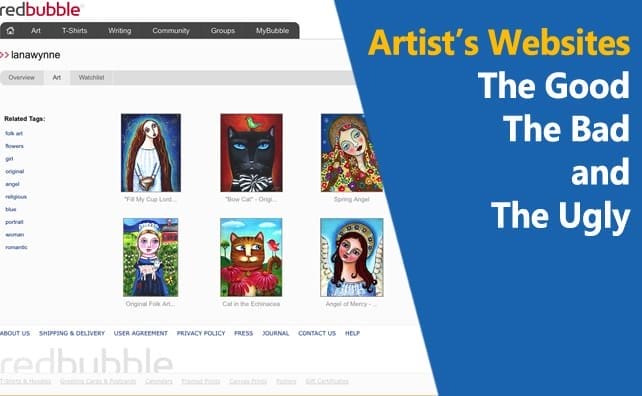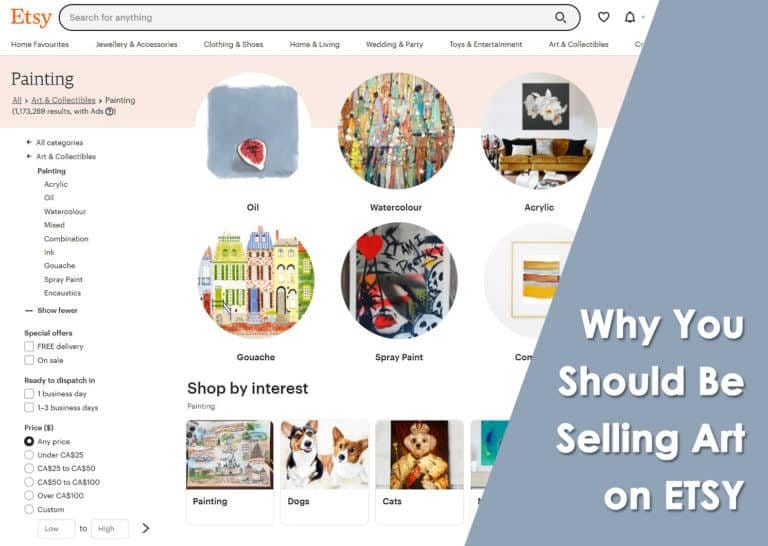You’re an artist looking to sell your work online and heard about Society6. Is it a good platform for you? Well, it depends on your goals.
Society6 offers a wide range of products and global exposure, which can be great for seeing your art. But the low commission rates might not be ideal if you’re after big profits. There’s also the question of printing quality and how much control you’ll have over your work.
Is Society6 Good for Artists? Before you decide, you’ll want to evaluate these factors and how they stack up against other platforms. Let’s explore the pros and cons to help you make an informed choice.
DISCOVER MORE: Selling on Society6 for Artists
How Much Do Artists Make on Society6

Society6’s default profit margin on most products is 10% of the sale price. However, for certain products, such as art prints, framed prints, and canvas prints, artists can set their own markup, which allows them to determine the percentage profit they make on those items. For other products like apparel, home decor, and accessories, the profit margin remains fixed at 10%.
This means if you sell a $20 print, you’ll make $2. It’s not a lot, but it can add up if you sell many items. Society6 handles production, shipping, and customer service, letting you focus on creating art.
Based on a review of social media, Artists on Society6 can experience a wide range of earnings. Some artists report making between $700 to $800 monthly on average, with a few pieces consistently driving sales.
The income potential largely depends on factors such as the artist’s work’s visibility, their marketing efforts’ effectiveness, and the impact of Society6’s algorithm on their designs. Additionally, recent changes to Society6’s policies, including introducing subscription plans and deductions for shipping fees, have influenced how much artists can earn on the platform.
Where Does Society6 Ship From?

Society6 partners with vendors worldwide to make shipping faster and more efficient. These vendors are in several countries, including Australia, Germany, Italy, the United Kingdom, South Korea, and the United States.
Each vendor produces specific products, so even if you’re close to one of them, your order may still ship from a different location. This global network allows Society6 to serve customers worldwide, making sharing your art with a global audience easier.
This decentralized approach to e-commerce helps Society6 serve a global audience efficiently. It’s good for you as an artist because your work can reach customers worldwide without worrying about shipping logistics. However, it also means you can’t control exactly where your art is printed or shipped from. Society6 handles all aspects of order fulfillment, allowing you to focus on creating and promoting your art.
Society6 Printing Quality

Users have been concerned about Society6’s printing quality, with many artists and customers reporting inconsistent experiences.
Here are some key points regarding the quality of products offered by Society6:
General Quality Feedback
- Inconsistent Quality: Many users have reported issues with print quality, including blurry images and misaligned prints. Some customers have noted that products like masks and rugs have arrived with defects, such as blurry prints or designs printed askew[1][3].
- Product Variability: The quality can vary significantly depending on the item and the printing partner used for fulfillment. Some users have experienced good quality with certain products while encountering issues with others, leading to a perception of poor overall quality control[3][4].
- Recent Complaints: There has been a noticeable increase in complaints regarding product quality in recent years. Customers have reported problems such as damaged items, frayed fabrics, and discrepancies in size compared to what was advertised[3][4].
Customer Service Experience
- Refunds and Replacements: While some customers have received refunds for defective items, others have expressed frustration with the customer service process. Complaints include long response times and difficulties in resolving issues, which can add to the dissatisfaction with product quality[1][2][3].
Comparison with Other Platforms
- Competition: Some artists have compared Society6 unfavorably to other print-on-demand platforms like Redbubble and InPrint, which they claim offer higher quality prints and better customer service. This has led some artists to consider switching platforms due to quality concerns[4].
Overall, while Society6 offers a wide range of products, the quality of printing and materials has come under scrutiny, with many users advocating for improved quality control and customer service.
Does Society6 Own Your Art?
When you upload your artwork to Society6, you might wonder about the ownership rights. Rest assured, Society6 doesn’t claim ownership of your art. As an artist platform, they respect your intellectual property. You retain full rights to your work when selling art online through their online marketplace.
Here’s what you need to know about your art on Society6:
- You keep copyright: Your artwork remains yours, even after uploading.
- Non-exclusive license: Society6 gets permission to use your art on products, but not exclusively.
- You can sell elsewhere: You can use your art on other platforms or in other ways.
Society6 is part of the digital art community that supports artists. They don’t restrict you from using your art on other online marketplaces. This flexibility is excellent for artists who want to expand their reach. You can upload the same designs to multiple platforms without worry.
Society6 vs Printful
Two major print-on-demand platforms, Society6 and Printful, offer different benefits for artists looking to sell their work online. Here’s a breakdown of the differences.
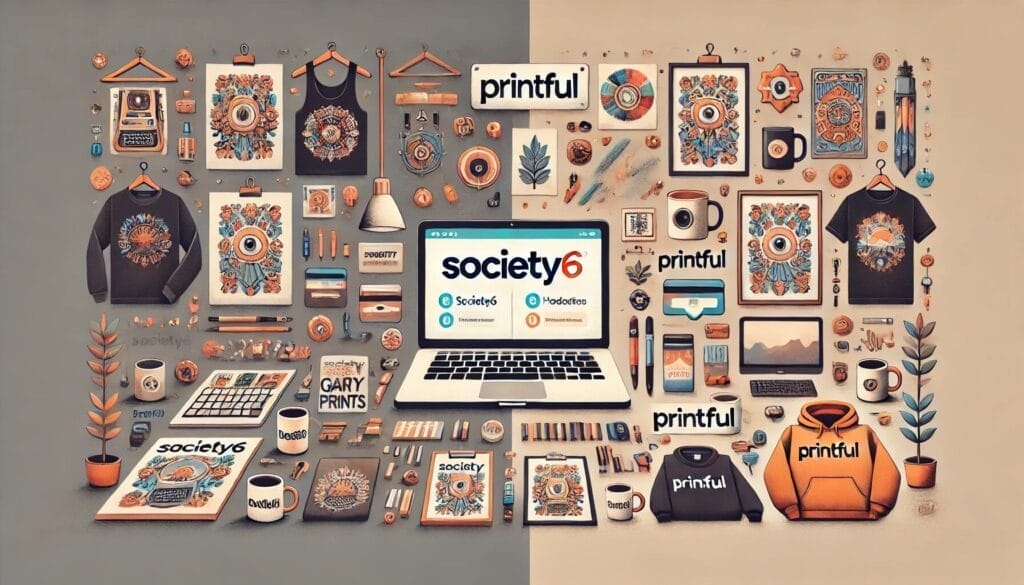
Society6 is a marketplace where you can upload your art and sell it on various products. Printful is a fulfillment service that integrates with your online store. Both platforms have their strengths in art marketing and e-commerce.
From an artist’s perspective, here are the main differences between Society6 and Printful:
Business Model:
- Society6: Operates as a marketplace where artists upload designs and Society6 handles production, shipping, and customer service.
- Printful: Acts as a fulfillment service that integrates with e-commerce platforms, allowing artists to sell directly through their own online stores.
Control and Branding:
- Society6: Limited control over branding and customer interaction, as artists are part of a larger marketplace.
- Printful: Offers more control over branding and customer relationships, as artists can manage their stores and marketing.
Pricing and Profit Margins:
- Society6: Takes a significant commission from sales, which can limit profit margins for artists.
- Printful: Allows artists to set their prices, potentially leading to higher profit margins, but artists must cover production and shipping costs.
Subscription and Fees:
- Society6: Recently introduced subscription plans with fees, and deducts shipping fees from artist earnings.
- Printful: No subscription fees, but artists pay for each item produced and shipped.
Product Quality and Control:
- Society6: Mixed reviews on product quality, with some artists reporting inconsistent print quality.
- Printful: Generally praised for high-quality prints and products.
Audience and Reach:
- Society6: Provides access to a large audience through its marketplace, which can benefit visibility.
- Printful: Requires artists to drive their traffic, as it does not have a built-in marketplace.
These differences highlight the trade-offs between using a marketplace like Society6 and a fulfillment service like Printful, depending on an artist’s goals and business strategy.
Society6 vs Fine Art America
Society6 and Fine Art America are popular platforms for artists to sell their work online, but they have distinct differences in their approach and offerings.

Society6 excels at print-on-demand products, allowing you to monetize your art on various items, from home decor to accessories. In contrast, Fine Art America focuses on fine art prints and offers a more traditional sales approach.
While Society6’s global shipping network and ease of use make it appealing, Fine Art America’s focus on high-quality prints and direct customer interaction may resonate with artists seeking a more personalized experience.
Here is a bullet-point list highlighting these differences and factors to help artists decide which platform might be more suitable for them:
Business Model:
- Society6: Operates as a marketplace where artists upload designs, and Society6 handles production, shipping, and customer service.
- Fine Art America: Also a marketplace but offers additional features like artist websites and more control over the selling process.
Subscription and Fees:
- Society6: Recently introduced subscription plans with fees, with a free plan limiting artists to 10 designs and a fixed 10% royalty. Paid plans allow for more designs and the ability to set prices.
- Fine Art America: Charges a flat annual fee of $30 for a Premium membership, allowing for more than 25 uploads, which is often seen as more cost-effective.
Control Over Pricing:
- Society6: Sets product prices, and artists earn a fixed royalty percentage unless they opt for a paid plan.
- Fine Art America: Allows artists to set their own markups, providing more control over pricing and potential earnings.
Product Range:
- Society6: Offers a wide range of products, including art prints, home decor, and apparel.
- Fine Art America: Primarily focuses on art prints and framed artwork but also offers some additional products like home decor and apparel.
Audience and Reach:
- Society6: Its marketplace provides access to a large audience, but visibility can be competitive and influenced by the platform’s algorithms.
- Fine Art America: Offers a large audience with additional features like artist websites and marketing tools to help artists reach potential buyers.
Profit Margins:
- Society6: Earnings can be limited by the platform’s commission structure and recent subscription fees.
- Fine Art America: Artists can potentially earn more by setting their own prices, although they must pay an annual fee.
How to Choose
- Budget and Fees: Consider the cost of subscription plans and fees. Fine Art America’s flat annual fee might be more predictable than Society6’s tiered subscription plans.
- Control Over Pricing: If having control over pricing is important, Fine Art America offers more flexibility.
- Product Range: Choose based on the types of products you want to offer. Society6 has a broader range, while Fine Art America focuses more on traditional art prints.
- Audience and Marketing: Consider how much effort you will put into marketing. Society6 may require more self-promotion due to its competitive nature, while Fine Art America offers tools to assist with marketing.
- Long-term Goals: Think about your long-term goals as an artist. If you want to build a brand and have more control, Fine Art America might be more suitable. If you prefer a more hands-off approach, Society6 could be a better fit.
Both platforms offer opportunities for artists to reach a global audience. Society6 is better for those who want to sell their art on various products with less pricing control. Fine Art America is ideal for artists who prefer to focus on prints and want more control over their earnings. Consider your goals and preferences when choosing between these platforms for your online art business.
Society6 vs Redbubble
Both popular print-on-demand platforms, Society6 and Redbubble, offer artists unique opportunities to sell their work online. They’re the go-to for designers creating online stores without handling production or shipping.
Both platforms offer print-on-demand products, but they cater to different creative visions. Society6 focuses on a broader range of products, including home decor and accessories, while Redbubble excels at quirky, pop culture-inspired items like phone cases, stickers, and apparel.
When comparing Society6 and Redbubble, artists should consider several factors to determine which platform might be more suitable for selling their art. Here are the main differences and considerations:
Society6
- Marketplace Model: Society6 operates as a marketplace where artists upload designs, and the platform manages production, shipping, and customer service.
- Subscription Fees: Society6 has introduced subscription plans that require artists to pay fees for certain features and visibility, which can affect profit margins.
- Product Range: Offers various products, including art prints, home decor, and apparel.
- Visibility and Sales: Due to the competitive nature of the platform’s marketplace, artists may find it challenging to gain visibility without external promotion.
- Profit Margins: Society6 sets product prices, and artists earn a fixed royalty percentage, which can limit earnings.
Redbubble
- Ease of Use: Redbubble is often praised for its user-friendly interface and streamlined process for uploading designs across multiple products.
- Product Range: Similar to Society6, Redbubble offers a wide range of products, including clothing, stickers, and home decor.
- Artist Control: Artists have more control over their storefronts and can easily manage their designs across different products.
- Visibility and Sales: Redbubble’s search algorithm is considered more favorable for smaller shops, potentially offering better organic visibility for new artists.
- Profit Margins: Like Society6, Redbubble also takes a significant commission, but artists have more flexibility in setting their own product markups.
How to Choose
- Budget and Fees: Consider the cost of subscription plans and potential fees. Redbubble does not charge subscription fees, which might benefit artists on a budget.
- Control and Flexibility: If you value having more control over your storefront and product offerings, Redbubble might be a better choice.
- Product and Audience Fit: Consider the types of products you want to offer and the audience you wish to reach. Although both platforms offer similar ranges, audience engagement and visibility might differ.
- Promotion and Marketing: Evaluate how much effort you will put into promoting your work. Society6 may require more external marketing due to its competitive marketplace.
DISCOVER MORE: Selling on Redbubble for Artists
Ultimately, the choice between Society6 and Redbubble depends on your artistic style, product preferences, and desired level of community involvement. If you’re looking for a platform that resonates with a younger, fandom-driven audience, Redbubble might be the better fit.
Society6 vs INPRNT
Society6 and Inprnt offer distinct experiences. Society6 excels at print-on-demand products, allowing you to monetize your art on various items. Inprnt, on the other hand, focuses exclusively on high-quality art prints, offering a more traditional and professional sales approach.
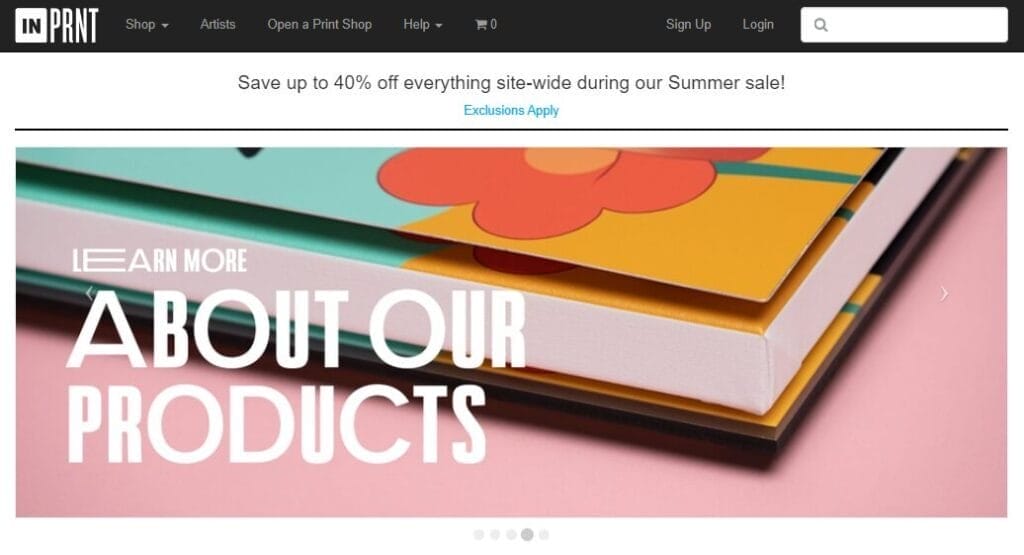
Inprnt’s curated aesthetic and artist-focused features, such as customizable portfolios and direct customer interaction, may appeal to artists seeking a more sophisticated online presence.
In contrast, Society6 offers a wide range of products for your designs, from prints to home decor. It’s great for makers who want to diversify their offerings.
Society6
- Marketplace Model: Society6 functions as a large online marketplace where artists upload designs, and the platform handles production, shipping, and customer service.
- Subscription Plans: Society6 has introduced subscription plans that require artists to pay fees for certain features and visibility. A free plan limits the number of designs and offers a fixed royalty percentage.
- Product Range: Offers various products, including art prints, home decor, and apparel, allowing artists to diversify their offerings.
- Audience and Reach: Society6 has a more extensive customer base, which can benefit visibility, but the marketplace is competitive. Artists may need to promote their work externally to gain traction.
- Profit Margins: Society6 sets product prices, and artists earn a fixed royalty percentage, which can limit earnings.
INPRNT
- Focus on Quality: INPRNT is known for producing high-quality art prints, which can be a significant advantage for artists prioritizing print quality.
- Niche Audience: While INPRNT receives less traffic than Society6, the audience is more targeted, with visitors specifically looking to purchase art prints.
- Commission Structure: INPRNT takes a lower commission than Society6, potentially allowing artists to earn more per sale.
- Limited Product Range: Primarily focuses on art prints, offering fewer product options than Society6.
- Artist Selection: INPRNT is more selective about the artists it accepts, which can create a sense of exclusivity and potentially reduce competition among artists on the platform.
How to Choose
Platform Exclusivity: If being part of a more exclusive community is important, INPRNT’s selective artist acceptance might be appealing.d use tags to improve visibility. INPRNT’s setup is simpler, focusing on showcasing your art without much fuss.
Quality vs. Quantity: If print quality is a priority, INPRNT may be the better choice. For artists looking to offer a wide range of products, Society6 might be more suitable.
Audience and Marketing: Consider the type of audience you want to reach. Society6 offers a broader audience, while INPRNT’s audience is more niche and focused on art prints.
Control and Profit: Evaluate the commission structure and potential earnings. INPRNT’s lower commission might result in higher profits per sale.
Ultimately, the choice between Society6 and Inprnt depends on your artistic goals, product preferences, and desired level of professionalism. If you’re looking for a platform that prioritizes art prints and artist credibility, Inprnt might be the better fit.
Society6 vs Cafepress
As an artist, comparing Society6 and CafePress reveals two distinct approaches to online sales. Society6 excels at modern, design-driven products and a user-friendly interface, making monetizing your art on a wide range of items accessible. Conversely, CafePress has a more traditional feel, focusing on customizable products like t-shirts, mugs, and tote bags.
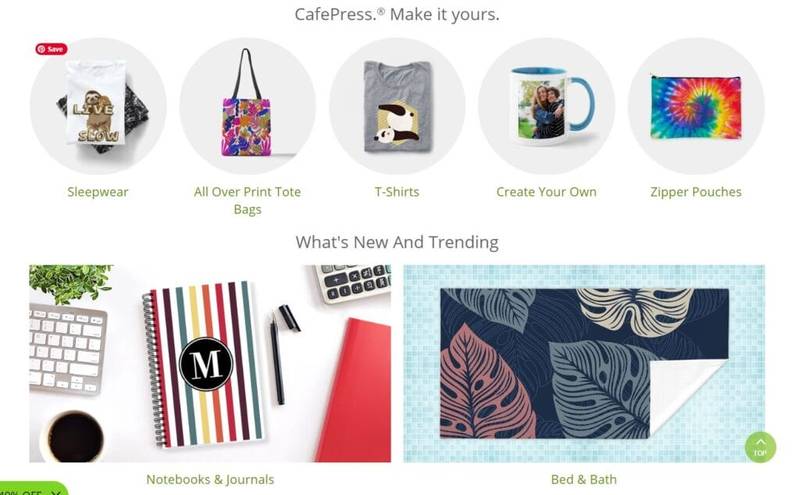
While CafePress offers more control over pricing and product selection, its website and shopping experience feel less streamlined than Society6. CafePress’s broader range of products, including more niche items, may appeal to artists with diverse creative interests.
Society6
- Marketplace Model: Society6 operates as a marketplace where artists upload designs. The platform handles production, shipping, and customer service.
- Product Range: Offers a wide variety of products, including art prints, home decor, and apparel, allowing artists to diversify their offerings.
- Subscription Fees: Society6 has introduced subscription plans that require artists to pay fees for certain features and visibility, which can affect profit margins.
- Profit Margins: Society6 sets product prices, and artists earn a fixed royalty percentage, which can limit earnings.
- Visibility: Due to the competitive nature of the platform’s marketplace, artists may find it challenging to gain visibility without external promotion.
CafePress
- Customization and Control: CafePress allows for more customizable markups, giving artists more control over their profit margins.
- Product Range: Similar to Society6, CafePress offers various products, including clothing, accessories, and home goods.
- Art Restrictions: CafePress has strict policies regarding licensed content, so artists must avoid alluding to licensed material or pop culture references.
- Community and Support: CafePress does not have as strong a community or social aspect as some other platforms, which might affect networking opportunities for artists.
How to Choose
Promotion and Marketing: Evaluate how much effort you will put into promoting your work. Society6 may require more external marketing due to its competitive marketplace.
Pricing and Fees: Consider the cost of subscription plans and potential fees. CafePress offers more control over pricing, which might benefit artists looking to maximize profit margins.
Product Focus: Choose based on the types of products you want to offer. Although the range of products on both platforms is similar, the audience engagement and visibility might differ.
Art and Content Policies: If your work includes pop culture references, Society6 might be more lenient than CafePress, which has stricter content policies.
Ultimately, the choice between Society6 and CafePress depends on your artistic style, product preferences, and desired level of customization. If you’re looking for a platform that balances ease of use with flexibility in product design, Society6 might be the better fit. Still, CafePress is worth considering if you prefer more control over your products and pricing.



